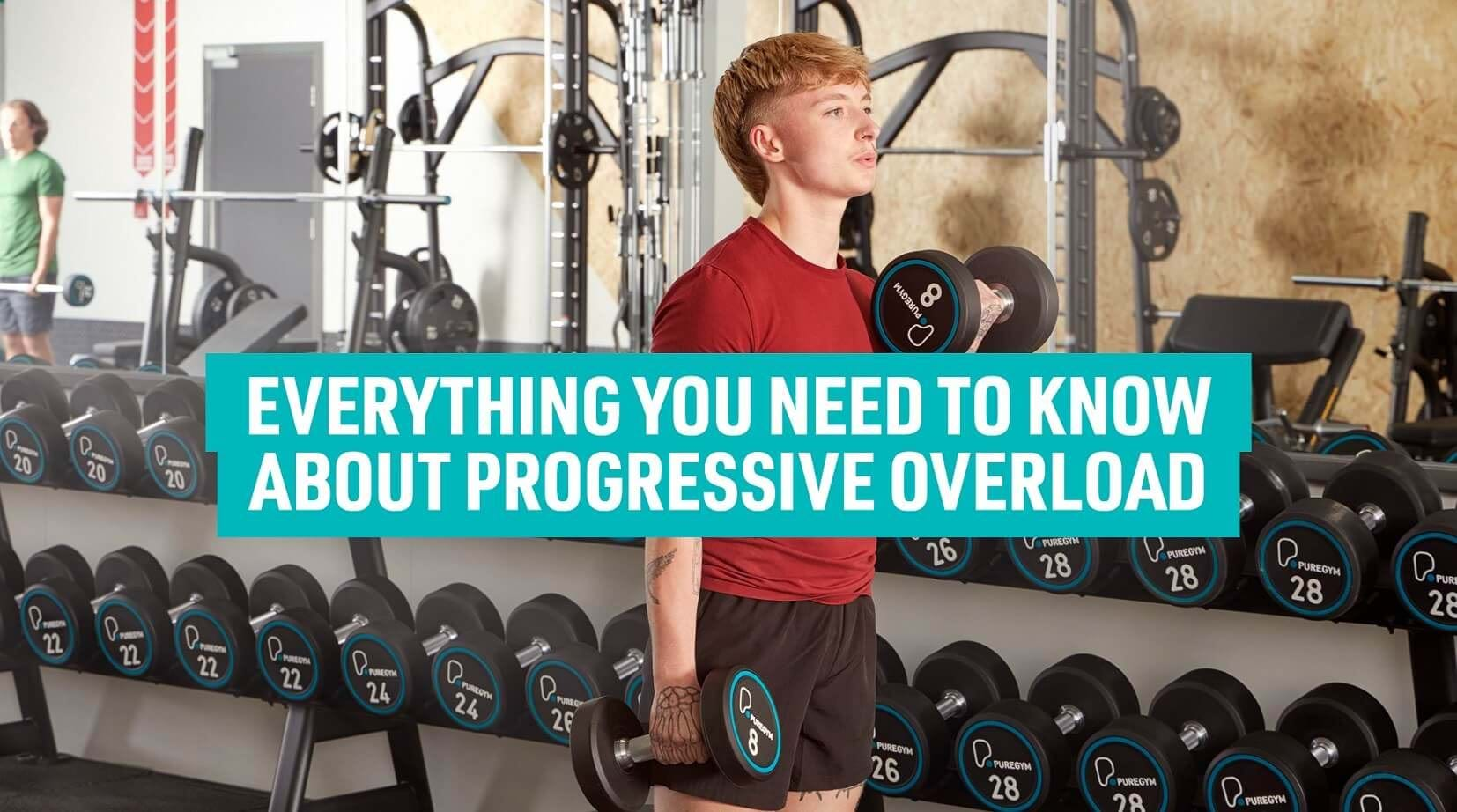Progressive Overload: What Is It, Examples And Workout Plans

What Is Progressive Overload? | Why Is Progressive Overload Important? | Examples Of Progressive Overload | Progressive Overload Tips | Progressive Overload Workout Plan | FAQs
Ever found yourself hitting a plateau in your fitness journey? Felt frustrated by little-to-no progress despite putting in the effort at the gym? Don't worry, you're not alone!
Progressive overload is one of the best ways to push your body's limits, break through a fitness plateau and increase muscle growth and strength development over time. By gradually increasing the demands placed on your muscles, you'll not only see improvements in your physique but also enhance your overall performance and endurance.
To get the most out of progressive overload, you'll need to stick to a specific training plan. PureGym Portsmouth North Harbour PT and Assistant Gym Manager Phil Carpenter has created a progressive training plan for all fitness levels, which you can jump straight to here.
What Is Progressive Overload?
Progressive overload is a training principle where you gradually increase the intensity, volume, or duration of your workouts over time to challenge your muscles and stimulate growth. Progressive overload is key for anyone looking to continually improve strength, endurance, or muscle mass.
Why Is Progressive Overload Important?
Our bodies are excellent at adapting to anything they are exposed to, including exercise. The more we do something, the more efficient we get at doing it, and the less challenging it becomes. You might have noticed this in your training, as the same weights and sets that you first found challenging become easier.
Continuing to exercise with the same intensity that no longer challenges the body will see any strength, endurance, and muscle mass gains plateau, as the body is no longer being challenged enough to force the adaptation needed to improve over time.
Progressive overload allows the body to be exposed to a greater challenge in a sustainable level, improving your strength and fitness while minimising risk of injury.
5 Examples Of Progressive Overload
There are a few ways to add progressive overload into your training. Most people find a mix of the below work best depending on factors such as their goals and the amount of time they have to train each week.
Increasing the weight. One of the most common methods of progressive overload is to gradually increase the amount of weight you lift. Start with a weight that challenges you but allows you to complete your desired number of repetitions with proper form. As you get stronger, gradually increase the weight to continue challenging your muscles.
Adding repetitions or sets. Another way to progressively overload your muscles is to increase the number of repetitions or sets you perform for each exercise. This method is often paired with increasing the weight, to avoid ending up with hundreds of repetitions, by working within a rep range. For example, working within a rep range of 8-12 you would start with a weight that challenges you for 8 reps, and increasing the reps until you can do 12. You would then increase the weight until you can do 8 reps and begin again.
Increasing time under tension. Increasing the time your muscles are under tension is another way to progressive overload. This can be done in a few ways, including holds or pulses to an exercise, slowing down the eccentric part of the exercise, adding in drop sets, or decreasing rest time.
Increasing how often you work out. Increasing the frequency of your workouts can also be a form of progressive overload. Instead of training a muscle group once a week, try training it two or three times a week to provide more stimulus for growth. Like with increasing reps, there is a limit to how often this technique can be used so it's best paired with other forms of progressive overload.
Choosing harder exercises. Progressively challenging your muscles can also involve changing the exercises you perform or the equipment you use. For example, you can progress from bodyweight squats to weighted squats or from dumbbell chest presses to barbell bench presses.
Progressive Overload Tips
The principle of progressive overload can be applied to any workout, including cardio workouts. If you have a workout plan you enjoy and want to progressively overload it, here are some tips:
Track your workouts. Tracking your workouts is an important tool for progressive overload. Without tracking, it's difficult to increase the intensity each week as you don't have a record of previous metrics.
Stay consistent. It's difficult to progressive overload if you are doing different workouts each week. Stick to the same routine for a minimum of 4-6 weeks while increasing the intensity. If you are seeing no progress after this time, you can adjust your training and go from there.
Increase intensity slowly. While no two people are the same, a good rule of thumb is to increase the intensity of your workout by 10% a week to avoid injury. For example, moving from 10 reps to 11 reps, or 20kg to 22kg. Avoid changing multiple factors each week as this can overload the body too quickly and cause injury.
Listen to your body. If you are feeling excessively tired or constantly sore, it may be a sign that you're progressing too fast or not allowing your body enough recovery time.
Progressive Overload Workout Plan
PureGym PT Phil Carpenter has put together a 12 week workout plan suitable for beginner, intermediate, and advanced lifters. The plan is split into three phases, each containing a full body workout that can be repeated throughout the week or paired with a different full body workout.
Weeks 1-4: Foundation Phase
- Objective: Gradually build strength and endurance
- Frequency: 3-4 days a week
- Weights: Aim for a weight that is challenging for 10 reps, increasing as this gets comfortable
Exercises
Squats: 3 sets of 10-12 reps
Bench press: 3 sets of 10-12 reps
Bent over rows: 3 sets of 10-12 reps
Leg press: 3 sets of 10-12 reps
Overhead dumbbell press: 3 sets of 10-12 reps
Weeks 5-8: Development Phase
- Objective: Gradually build strength and endurance
- Frequency: 3-4 days a week
- Weights: Aim for a weight that is challenging for 10 reps, increasing as this gets comfortable
Exercises
Deadlifts: 4 sets of 8-10 reps
Incline bench press: 4 sets of 8-10 reps
Lat pulldowns: 4 sets of 8-10 reps
Leg curls: 4 sets of 8-10 reps
Shoulder press machine: 4 sets of 8-10 reps
Weeks 9-12: Intensification Phase
- Objective: Focus on building maximum strength
- Workout Frequency: 4 days a week
- Weight: Choose a weight that allows you to complete 6-8 reps with good form but feels challenging by the final reps.
Exercises
Front squats: 5 sets of 6-8 reps
Dumbbell chest flyes: 5 sets of 6-8 reps
One arm dumbbell rows: 5 sets of 6-8 reps
Calf raises: 5 sets of 6-8 reps
Arnold press: 5 sets of 6-8 reps
Need A Specific Progressive Overload Plan?
Whether you're new to the gym or you're looking to push through a plateau, a specific progressive overload plan can help you achieve your fitness goals more effectively.
If you're looking to start your progressive overload training now, you can find a PureGym near you and become a member today. Our gyms are filled with high-quality weights machines and free weights, so you can start getting stronger either on your own.
Alternatively, you could also speak to Phil or one of our other certified personal trainers and they'll help you create your own progressive overload plan.
Progressive Overload FAQs
How often should you progressive overload?
Progressive overload should be applied consistently in your training routine, but the rate of progression can vary based on factors such as your fitness level, goals, and recovery capacity. Aim to gradually increase the intensity, volume, or duration of your workouts every 1-4 weeks to ensure continued progress while allowing adequate recovery time.
Can you build muscle without progressive overload?
While muscle growth can happen without progressive overload, especially for beginners or individuals returning to training after a layoff, consistent progressive overload is the most effective way to stimulate muscle growth over time. Without progressively increasing the demands on your muscles, your progress may plateau, and muscle growth may become limited.
Can you progressive overload while cutting?
Yes, it's possible to apply progressive overload principles while cutting (reducing body fat). However, the rate of progression may be slower compared to when you're in a caloric surplus (bulking). Focus on maintaining strength levels and adjusting training variables such as volume and intensity to match your energy availability and recovery capacity during a cutting phase.
Do you have to progressive overload?
Progressive overload is not strictly mandatory, but it's highly recommended for maximising strength and muscle gains, improving fitness levels, and breaking through plateaus. Without progressively challenging your muscles, you probably won't see significant improvements in strength, muscle size, or performance, despite consistently hitting the gym.
Does progressive overload burn fat?
Yes and no - progressive overload's main function is to promote muscle growth and strength gains rather than directly burning fat. However, all workouts burn calories and increasing muscle mass through progressive overload can indirectly contribute to fat loss by boosting metabolism and enhancing calorie expenditure at rest.
If you're looking to burn fat, you'd be better off trying out some of our top calorie-burning exercises in addition to strength training.


